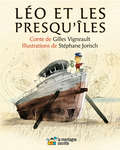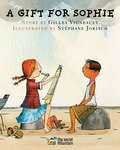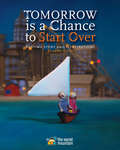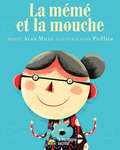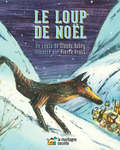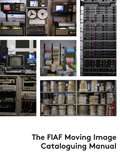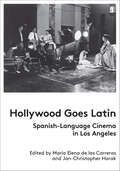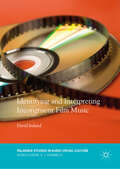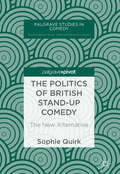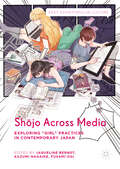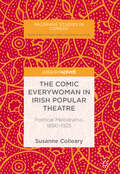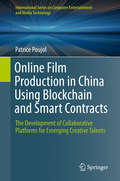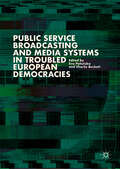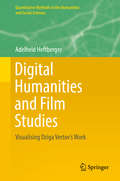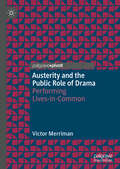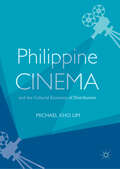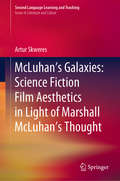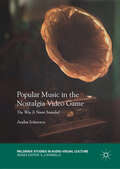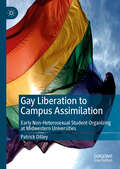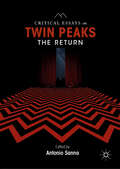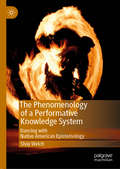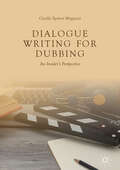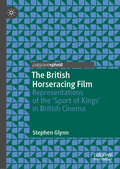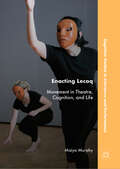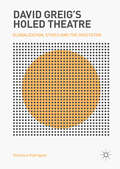- Table View
- List View
Léo et les presqu'îles
by Gilles VigneaultCette magnifique fable relate l'aventure de LÉo, le fils d'un pÊcheur disparu en mer. Parti explorer le monde des cinq presqu'Îles, LÉo fait la rencontre de personnages hauts en couleur qui ont bien connu son pÈre. Avec leur aide, il devient le plus petit capitaine d'un grand bateau. Un livre sur la transmission familiale, et la soif de dÉcouverte !
A Gift for Sophie
by Gilles VigneaultWinner of:Parents' Choice Recommended Award In this touching, poetic story set by the seaside, Old Man Tom teaches Sophie and Emilio the importance of seeing the world through their hearts. Presenting children with profound messages about friendship and gifts as well as old age and continuity, the book and accompanying CD offers a heartwarming perspective for the whole family. In addition to a production of the narrated story, the CD includes nine songs ranging from "A Friend That I Like" and "It's in the Nature of Things" to "I Have a Nest Full" and "The Old Man's House."
Tomorrow Is a Chance to Start Over
by Hilary GristWinner of:2015 National Association of Parenting Publications, Gold Award2015 Parents' Choice RecommendedNominee:2015 Canadian Folk Music Award, Best Children's AlbumA fresh, original project that will appeal to young parents who are fans of musical artists Feist or Norah Jones Ira and Isabelle, who live in a little red house by the sea, decide one night to escape the sound of the city's beeping cars and sail off to a faraway land where they learn from a new friend—a robin with a soft voice—that dreams really can come true. The book contains an audio CD that features the narrated story as well as 10 original heartwarming dream songs, and an ethereal rendition of Johannes Brahms' classic "Cradle Song."
La mémé et la mouche
by Alan Mills PisHierUn classique du rÉpertoire enfantin en AmÉrique-du-Nord, l'histoire rigolote d'une vieille dame qui a les yeux plus gros que la panse !
Le loup de Noël
by Claude AubryMaÎtre Griboux, un vieux loup des Laurentides, maussade et solitaire, n'a plus rien À manger. AffamÉ, il descend au village la veille de NoËl oÙ il est attirÉ par la chaleur et les lumiÈres de l'Église. Il entre durant la messe de minuit et voit un enfant, tout potelÉ, couchÉ dans une crÈche. Perdant toute prudence, il se prÉcipite pour le dÉvorer devant une assemblÉe paralysÉe d'Étonnement. Heureusement, le curÉ intervient pour Épargner l'animal qui deviendra l'ami des enfants.
The FIAF Moving Image Cataloguing Manual
by Linda TadicThe FIAF Moving Image Cataloguing Manual is the result of many years of labor and collaboration with numerous professionals in the moving image field. It addresses the changes in information technology that we’ve seen over the past two decades, and aligns with modern cataloguing and metadata standards and concepts such as FRBR (Functional Requirements for Bibliographic Records), EN 15907, and RDA (Resource Description and Access). The manual is designed to be compatible with a variety of data structures, and provides charts, decision trees, examples, and other tools to help experts and non-experts alike in performing real-world cataloguing of moving image collections.
Hollywood Goes Latin: Spanish-Language Cinema in Los Angeles
by María Elena de las Carreras and Jan-Christopher HorakIn the 1920s, Los Angeles enjoyed a buoyant homegrown Spanish-language culture comprised of local and itinerant stock companies that produced zarzuelas, stage plays, and variety acts. After the introduction of sound films, Spanish-language cinema thrived in the city's downtown theatres, screening throughout the 1930s, 1940s, and 1950s in venues such as the Teatro Eléctrico, the California, the Roosevelt, the Mason, the Azteca, the Million Dollar, and the Mayan Theater, among others. With the emergence and growth of Mexican and Argentine sound cinema in the early to mid-1930s, downtown Los Angeles quickly became the undisputed capital of Latin American cinema culture in the United States. Meanwhile, the advent of talkies resulted in the Hollywood studios hiring local and international talent from Latin America and Spain for the production of films in Spanish. Parallel with these productions, a series of Spanish-language films were financed by independent producers. As a result, Los Angeles can be viewed as the most important hub in the United States for the production, distribution, and exhibition of films made in Spanish for Latin American audiences. In April 2017, the International Federation of Film Archives organized a symposium, "Hollywood Goes Latin: Spanish-Language Cinema in Los Angeles," which brought together scholars and film archivists from all of Latin America, Spain, and the United States to discuss the many issues surrounding the creation of Hollywood's "Cine Hispano." The papers presented in this two-day symposium are collected and revised here.This is a joint publication of FIAF and UCLA Film & Television Archive.
Identifying and Interpreting Incongruent Film Music (Palgrave Studies in Audio-Visual Culture)
by David IrelandThis book explores the concept of incongruent film music, challenging the idea that this label only describes music that is inappropriate or misfitting for a film’s images and narrative. Defining incongruence as a lack of shared properties in the audiovisual relationship, this study examines various types of incongruence between a film and its music and considers the active role that it can play in the construction of a film’s meaning and influencing audience response. Synthesising findings from research in the psychology of music in multimedia, as well as from ideas sourced in semiotics, film music, and poststructuralist theory, this interdisciplinary book provides a holistic perspective that reflects the complexity of moments of film-music incongruence. With case studies including well-known films such as Gladiator and The Shawshank Redemption, this book combines scene analysis and empirical audience reception tests to emphasise the subjectivity, context-dependency, and multi-dimensionality inherent in identifying and interpreting incongruent film music.
The Politics of British Stand-up Comedy: The New Alternative (Palgrave Studies in Comedy)
by Sophie QuirkThis Palgrave Pivot questions how a new generation of alternative stand-up comedians and the political world continue to shape and influence each other. The Alternative Comedy Movement of the late 1970s and 1980s can be described as a time of unruly experimentation and left-wing radicalism. This book examines how alternative comedians continue to celebrate these characteristics in the twenty-first century, while also moving into a distinct phase of artistic development as the political context of the 1970s and 1980s loses its immediacy. Sophie Quirk draws on original interviews with comedians including Tom Allen, Josie Long, John-Luke Roberts and Tony Law to chart how alternative comedians are shaped by, and in turn respond to, contemporary political challenges from neoliberalism to Brexit, class controversy to commercialism. She argues that many of our assumptions about comedy’s politics must be challenged and updated. This book is essential reading for anyone who wants to understand the working methods and values of today’s alternative comedians.
Shōjo Across Media: Exploring "Girl" Practices in Contemporary Japan (East Asian Popular Culture)
by Jaqueline Berndt Kazumi Nagaike Fusami OgiSince the 2000s, the Japanese word shōjo has gained global currency, accompanying the transcultural spread of other popular Japanese media such as manga and anime. The term refers to both a character type specifically, as well as commercial genres marketed to female audiences more generally. Through its diverse chapters this edited collection introduces the two main currents of shōjo research: on the one hand, historical investigations of Japan’s modern girl culture and its representations, informed by Japanese-studies and gender-studies concerns; on the other hand, explorations of the transcultural performativity of shōjo as a crafted concept and affect-prone code, shaped by media studies, genre theory, and fan-culture research. While acknowledging that shōjo has mediated multiple discourses throughout the twentieth century—discourses on Japan and its modernity, consumption and consumerism, non-hegemonic gender, and also technology—this volume shifts the focus to shōjo mediations, stretching from media by and for actual girls, to shōjo as media. As a result, the Japan-derived concept, while still situated, begins to offer possibilities for broader conceptualizations of girlness within the contemporary global digital mediascape.
The Comic Everywoman in Irish Popular Theatre: Political Melodrama, 1890-1925 (Palgrave Studies in Comedy)
by Susanne CollearyThis book is a comprehensive study of comic women in performance as Irish Political Melodrama from 1890 to 1925. It maps out the performance contexts of the period, such as Irish “poor” theatre both reflecting and complicating narratives of Irish Identity under British Rule. The study investigates the melodramatic aesthetic within these contexts and goes on to analyse a selection of the melodramas by the playwrights J.W. Whitbread and P.J. Bourke. In doing so, the analyses makes plain the comic structures and intent that work across both character and action, foregrounding comic women at the centre of the discussion. Finally, the book applies a “practice as research” dimension to the study. Working through a series of workshops, rehearsals and a final performance, Colleary investigates comic identity and female performance through a feminist revisionist lens. She ultimately argues that the formulation of the Comic Everywoman as staged “Comic” identity can connect beyond the theatre to her “Everyday” self. This book is intended for those interested in theatre histories, comic women and in popular performance.
Online Film Production in China Using Blockchain and Smart Contracts: The Development of Collaborative Platforms for Emerging Creative Talents (International Series on Computer Entertainment and Media Technology)
by Patrice PoujolThis book explores the use of Blockchain and smart contract technologies to develop new ways to finance independent films and digital media worldwide. Using case studies of Alibaba and in-depth, on-set observation of a Sino-US coproduction, as well as research collected from urban China, Hong Kong, Europe, and the USA, Online Film Production in China Using Blockchain and Smart Contracts explores new digital platforms and what this means for the international production of creative works. This research assesses the change in media consciousness from young urban audiences, their emergence as a potential participative and creative community within dis-intermediated, decentralised and distributed crowdfunding and crowdsourcing models. This research proposes solutions on how these young emerging local creative talents can be identified and nurtured early on, particularly those who now produce creative and artistic audiovisual content whether these works are related to film, Virtual Reality (VR), video game, graphic novels, or music. Ultimately, a new media content finance and production platform implementing blockchain is proposed to bring transparency in the film sector and open doors to emerging artists in digital media. Appropriate for both professionals and academics in the film industry as well as computer science.
Public Service Broadcasting and Media Systems in Troubled European Democracies
by Charlie Beckett Eva PołońskaThis book provides the most recent overview of media systems in Europe. It explores new political, economic and technological environments and the challenges they pose to democracies and informed citizens. It also examines the new illiberal environment that has quickly embraced certain European states and its impact on media systems, considering the sources and possible consequences of these challenges for media industries and media professionals. Part I examines the evolving role of public service media in a comparative study of Western, Southern and Central Europe, whilst Part II ventures into Europe’s periphery, where media continues to be utilised by the state in its quest for power. The book also provides an insight into the role of the European Union in preserving the independence and neutrality of public service media. It will be useful to students and researchers of political communication and international and comparative media, as well as democracy and populism.
Digital Humanities and Film Studies: Visualising Dziga Vertov's Work (Quantitative Methods in the Humanities and Social Sciences)
by Adelheid HeftbergerThis book highlights the quantitative methods of data mining and information visualization and explores their use in relation to the films and writings of the Russian director, Dziga Vertov. The theoretical basis of the work harkens back to the time when a group of Russian artists and scholars, known as the “formalists,” developed new concepts of how art could be studied and measured. This book brings those ideas to the digital age. One of the central questions the book intends to address is, “How can hypothetical notions in film studies be supported or falsified using empirical data and statistical tools?” The first stage involves manual and computer-assisted annotation of the films, leading to the production of empirical data which is then used for statistical analysis but more importantly for the development of visualizations. Studies of this type furthermore shed light on the field of visual presentation of time-based processes; an area which has its origin in the Russian formalist sphere of the 1920s and which has recently gained new relevance due to technological advances and new possibilities for computer-assisted analysis of large and complex data sets. In order to reach a profound understanding of Vertov and his films, the manual or computer-assisted data analysis must be combined with film-historical knowledge and a study of primary sources. In addition, the status of the surviving film materials and the precise analysis of these materials combined with knowledge of historical film technology provide insight into archival policy and political culture in the Soviet Union in the 1920s and 30s.
Austerity and the Public Role of Drama: Performing Lives-in-Common
by Victor MerrimanThis book asks what, if any, public role drama might play under Project Austerity – an intensification phase of contemporary liberal political economy. It investigates the erosion of public life in liberal democracies, and critiques the attention economy of deficit culture, by which austerity erodes life-in-common in favour of narcissistic performances of life-in-public. It argues for a social order committed to human flourishing and deliberative democracy, as a counterweight to the political economy of austerity. It demonstrates, using examples from England, Ireland, Italy, and the USA, that drama and the academy pursue shared humane concerns; the one, a critical art form, the other, a social enabler of critical thought and progressive ideas. A need for dialogue with emergent forms of collective consciousness, new democratic practices and institutions, shapes a manifesto for critical performance, which invites universities and cultural workers to join other social actors in imagining and enabling ethical lives-in-common.
Philippine Cinema and the Cultural Economy of Distribution
by Michael Kho LimThis book explores the complex interplay of culture and economics in the context of Philippine cinema. It delves into the tension, interaction, and shifting movements between mainstream and independent filmmaking, examines the film distribution and exhibition systems, and investigates how existing business practices affect the sustainability of the independent sector. This book addresses the lack or absence of Asian representation in film distribution literature by supplying the much-needed Asian context and case study. It also advances the discourse of film distribution economy by expounding on the formal and semi-formal film distribution practices in a developing Asian country like the Philippines, where the thriving piracy culture is considered as ‘normal,’ and which is commonly depicted and discussed in existing literature. As such, this will be the first book that looks into the specifics of the Philippine film distribution and exhibition system and provides a historical grounding of its practices.
McLuhan’s Galaxies: Science Fiction Film Aesthetics in Light of Marshall McLuhan’s Thought (Second Language Learning and Teaching)
by Artur SkweresThis groundbreaking book uses observations made by Marshall McLuhan to analyze the aesthetics of science fiction films, treating them as visual metaphors or probes into the new reality dominated by electronic media: - it considers the relations between the senses and sensuality in Blade Runner, the visually-tactile character of the film, and the status of replicants as humanity’s new clothes; - it analyzes the mixture of Eastern and Western aesthetics in Star Wars, analyzing Darth Vader as a combination of the literate and the tribal mindset; - it discusses the failure of visual society presented in the Terminator and Alien franchises, the rekindling of horror vacui, tribalism, and the desire to obliterate the past as a result of the simultaneity of the acoustic space; - finally, the book discusses the Matrix trilogy and Avatar as being deeply related in terms of the growing importance of tactility, easternization, tribalization, as well as connectivity and the implosion of human civilization.
Popular Music in the Nostalgia Video Game: The Way It Never Sounded (Palgrave Studies in Audio-Visual Culture)
by Andra IvănescuThis book looks at the uses of popular music in the newly-redefined category of the nostalgia game, exploring the relationship between video games, popular music, nostalgia, and socio-cultural contexts. History, gender, race, and media all make significant appearances in this interdisciplinary work, as it explores what some of the most critically acclaimed games of the past two decades (including both AAA titles like Fallout and BioShock, and more cult releases like Gone Home and Evoland) tell us about our relationship to our past and our future. Appropriated music is the common thread throughout these chapters, engaging these broader discourses in heterogeneous ways. This volume offers new perspectives on how the intersection between popular music, nostalgia, and video games, can be examined, revealing much about our relationship to the past and our hopes for the future.
Gay Liberation to Campus Assimilation: Early Non-Heterosexual Student Organizing at Midwestern Universities
by Patrick DilleyThis book outlines the beginning of student organizing around issues of sexual orientation at Midwestern universities from 1969 to the early 1990s. Collegiate organizations were vitally important to establishing a public presence as well as a social consciousness in the last quarter of the twentieth century. During this time, lesbian and gay students struggled for recognition on campuses while forging a community that vacillated between fitting into campus life and deconstructing the sexist and heterosexist constructs upon which campus life rested. The first openly gay and lesbian student body presidents in the United States were elected during this time period, at Midwestern universities; at the same time, pioneering non-heterosexual students faced criticism, condemnation, and violence on campus. Drawing upon interviews, extensive reviews of campus newspapers and yearbooks, and archival research across the Midwest, Patrick Dilley demonstrates how the early gay campus groups created and provided educational and support services on campus–efforts that later became incorporated into campus services across the nation. Further, the book shows the transformation of gay identity into a minority identity on campus, including the effect of alliances with campus racial minorities.
Critical Essays on Twin Peaks: The Return
by Antonio SannaThis edited collection offers an interdisciplinary study of Twin Peaks: The Return, the third season of a TV program that has attracted the attention (and appreciation) of spectators, fans, and critics for over two decades. The book takes readers into several distinct areas and addresses the different approaches and the range of topics invited by the multidimensionality of the subject itself: the philosophical, the artistic, the socio-cultural, and the personal. The eighteen chapters constituting the volume are academic in their approach to the subject and in their methodology, whether they apply a historical, psychoanalytical, film studies, or gender studies perspective to the text under examination. The variety and range of perspectives in these aforementioned chapters reflect the belief that a study of the full complexity of Twin Peaks: The Return, as well as a timely assessment of the critical importance of the program, requires both an interdisciplinary perspective and the fusion of different intellectual approaches across genres. The chapters demonstrate a collective awareness of the TV series as a fundamental milestone in contemporary culture.
The Phenomenology of a Performative Knowledge System: Dancing with Native American Epistemology (Performance Philosophy)
by Shay WelchThis book investigates the phenomenological ways that dance choreographing and dance performance exemplify both Truth and meaning-making within Native American epistemology, from an analytic philosophical perspective. Given that within Native American communities dance is regarded both as an integral cultural conduit and “a doorway to a powerful wisdom,” Shay Welch argues that dance and dancing can both create and communicate knowledge. She explains that dance—as a form of oral, narrative storytelling—has the power to communicate knowledge of beliefs and histories, and that dance is a form of embodied narrative storytelling. Welch provides analytic clarity on how this happens, what conditions are required for it to succeed, and how dance can satisfy the relational and ethical facets of Native epistemology.
Dialogue Writing for Dubbing: An Insider's Perspective
by Giselle Spiteri MiggianiThis book analyses an important phase in the interlingual dubbing process of audiovisual productions: the elaboration of target language scripts for the recording studios. Written by a practitioner in the industry who is also an academic and trainer, it provides practical know-how and guidelines while adopting a scholarly, structural and methodical approach. Supported by an exemplified, analytical and theoretical framework, it is non-language specific and discusses strategies and tricks of the trade. Divided into three parts, the book provides a descriptive, practical and analytical approach to dubbing and dialogue writing. The author analyses scripts drawn from her own professional practice, including initial drafts that illustrate the various transformations of a text throughout the rewriting process. She also offers a ‘backstage’ perspective, from first-hand experience in recording sessions that enabled knowledge of text manipulation, studio jargon, and the dubbing post production process. This publication will provide a valuable resource for novice dubbing translators and dialogue writers, while offering practitioner insights to scholars and researchers in the field of Audiovisual Translation, Film and Media Studies.
The British Horseracing Film: Representations of the ‘Sport of Kings’ in British Cinema
by Stephen GlynnThis book constitutes the first full volume dedicated to an academic analysis of horseracing in British cinema. Through comprehensive contextual histories of film production and reception, together with detailed textual analysis, this book explores the aesthetic and emotive power of the enduringly popular horseracing genre, its ideologically-inflected landscape and the ways in which horse owners and riders, bookmakers and punters have been represented on British screen. The films discussed span from the 1890s to the present day and include silent shorts, quota quickies and big-budget biopics. A work of social and film history, The British Horseracing Film demonstrates how the so-called “sport of kings” functions as an accessible institutional structure through which to explore cinematic discussions about the British nation—but also, and equally, national approaches to British cinema.
Enacting Lecoq: Movement In Theatre, Cognition, And Life (Cognitive Studies In Literature And Performance Ser.)
by Maiya MurphyThis book examines the theatrical movement-based pedagogy of Jacques Lecoq (1921-1999) through the lens of the cognitive scientific paradigm of enaction. The conversation between these two both uncovers more of the possible cognitive processes at work in Lecoq pedagogy and proposes how Lecoq’s own practical and philosophical approach could have something to offer the development of the enactive paradigm. Understanding Lecoq pedagogy through enaction can shed new light on the ways that movement, key to Lecoq’s own articulation of his pedagogy, might cognitively constitute the development of Lecoq’s ultimate creative figure – the actor-creator. Through an enactive lens, the actor-creator can be understood as not only a creative figure, but also the manifestation of a fundamentally new mode of cognitive selfhood. This book engages with Lecoq pedagogy’s significant practices and principles including the relationship between the instructor and student, identifications, mime, play, mask work, language, improvisation, and movement analysis.
David Greig’s Holed Theatre: Globalization, Ethics and the Spectator
by Verónica RodríguezWith a Foreword by Dan Rebellato, this book offers up a detailed exploration of Scottish playwright David Greig’s work with particular attention to globalization, ethics, and the spectator. It makes the argument that Greig’s theatre works by undoing, cracking, or breaking apart myriad elements to reveal the holed, porous nature of all things. Starting with a discussion of Greig’s engagement with shamanism and arguing for holed theatre as a response to globalization, for Greig’s works’ politics of aesthethics, and for the holed spectator as part of an affective ecology of transfers, this book discusses some of Greig’s most representative political theatre from Europe (1994) to The Events (2013), concluding with an exploration of Greig’s theatre’s world-forming quality.
